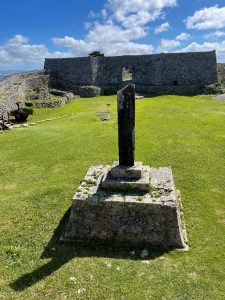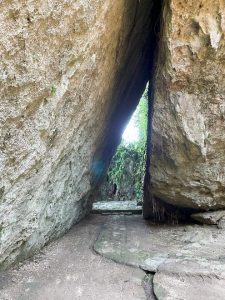Memoir (22) by Professor Joe Watkins, University of Arizona, USA
During the first week of June, I joined fellow GSI member Neil Price (Department of Archaeology and Ancient History, Uppsala University) and GSI Director Hirofumi Kato on a journey to Japan’s southernmost (and westernmost) prefecture – Okinawa.
Because of its location near China, Taiwan, and the islands of southern Oceania, Okinawa, as the main island of the Kingdom of Ryukyu, was a major trading relay center in the east-Asian trade network. It became a tributary state of the Tokugawa Shogunate in 1609 and was established as a Japanese prefect in 1879.
The complicated history of Okinawa is evident in three of its important sites — reconstructed Nakijin Castle of the Hokuzan (Northern) Kingdom, Nakagusuku Castle of the Chuzan (Middle) Kingdom, and the important religious site of Sȇfa-utaki.
Nakijin Gusuku
Nakijin Castle is estimated to have been built in the 13th century and was the home of the Aji until the Hanji took control in the 14th century and established the Hokuzan Kingdom, which was based at Nakijin Castle. In 1416, the Chuzan Kingdom conquered the Hokuzan Kingdom and stationed Lord Gosamaru as governor at Nakijin Castle. Gosamaru was said to have been a descendant of the Aji lords who originally built Nakijin Castle.
Nakagusuku
Nakagusuku Castle was built by Lord Sakinakagusuku in the mid-14th century and expanded upon by Lord Gosamaru in the early 15th century. Gosamaru was moved to Nakagusuku by the king in Shuri to check the rising power of Amawari Aji in Katsuren Castle to the northeast. However, in 1458, the castle fell to attacks by Amawari.
Sȇfa-utaki
According to the site’s brochure, Sefa-utaki is considered to be the most sacred site of Ryukyu Kingdom, and it appears in legends about the beginning of Ryukyu. In the distant Ryukyu dynasty, the most important ritual was the inauguration ceremony of the Kikoeogimi priestess called the “Oaraori.” The Kikoeogimi priestess (usually a close relative of the sitting king) was the highest priestess who oversaw and managed an extensive hierarchy of priestesses and shamanesses. While the traditional religion of the Ryukyuan Kingdom is not openly practiced today, people continue to make pilgrimages to this place.
Nakijin Castle, Nakagusuku Castle, and Sȇfa-utaki, along with several other related sites in Okinawa, were designated UNESCO World Cultural Heritage sites in 2000.
 Travelers 3 at Nakijin Castle
Travelers 3 at Nakijin Castle
 Nakagusuku Castle
Nakagusuku Castle
 A shrine for worship exists within this triangular space at Sȇfa-utaki.
A shrine for worship exists within this triangular space at Sȇfa-utaki.


